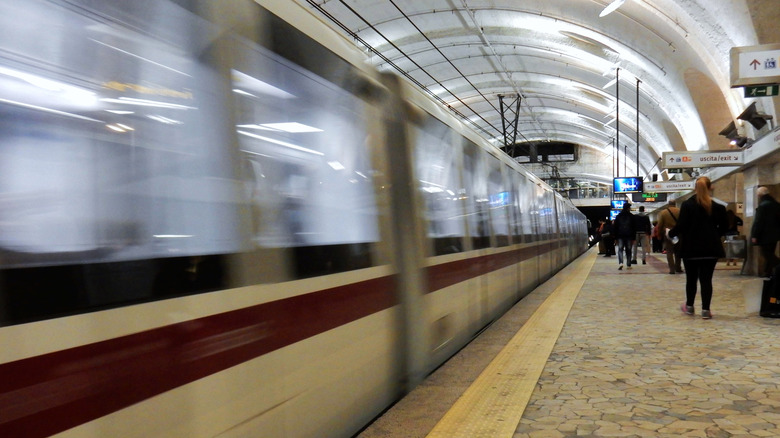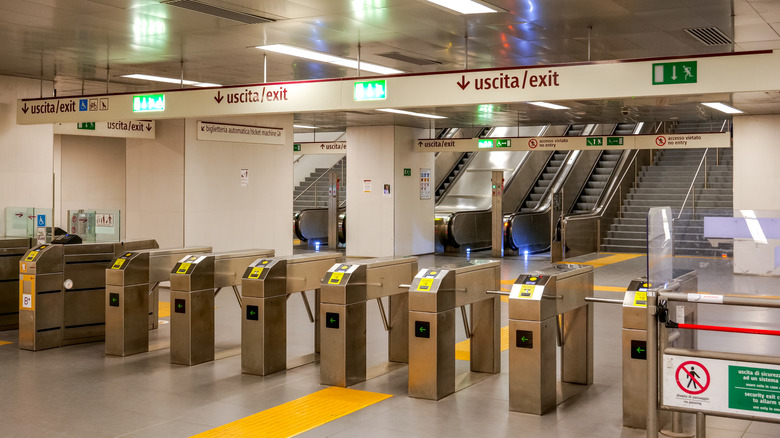This Transportation Method Is Best For Getting Around Rome (And You'll Look Like A Local)
Rome is a one-of-a-kind place to visit. The Eternal City is a whirl of mesmerizing, vibrant chaos, where modernity and ancient history walk shoulder to shoulder, and life somehow moves both fast and slow at once. It's the center of a global religion, was once the capital of one of the largest empires that ever existed, and is arguably one of the most influential cities in the history of the world. It boasts stunning ancient ruins, extraordinary churches, gorgeous historic architecture, and even has an entire separate country contained within its limits. And all this before you start to mention the food, fashion, and overall lifestyle that make Italy in general such an exciting destination.
The Eternal City is a surprisingly compact place, so even if you only have a day to spend in Rome, you can still get a lot done. However, with so much to see and do, it's important to maximize your time. There are a few tips and tricks for seeing Rome's most popular destinations without the crowds, but ultimately, if you want to make the most out of your trip, you'll need to find a way to get around the city quickly, efficiently, and ideally without breaking the bank!
Tourists often have a tendency to stick to taxis and rideshare apps when navigating a new city. Public transport can often seem confusing and hard to understand. But Rome's Metro system is easily the best way to get around the city. It's fast, affordable, and efficient, offering a simple, down-to-earth method of moving from one attraction to another. It's also the most popular mode of transport among Romans, giving you a bit of extra local credibility!
Using the Rome Metro
Rome's metro might be the smallest metro network in Europe, but it covers all the main attractions and is significantly more reliable than the creaking, unwieldy bus system that even locals tend to avoid as much as possible.
Rome's Metro is simple to understand, and the map is easy to decode. There are only three metro lines: A, B, and C (this isn't the byzantine complexity of the New York subway or the gloriously designed yet overwhelming map of the London Underground). Line A runs from Battistini in the northwest to Anagnina in the southeast, and goes past attractions like St. Peter's Basilica, the Vatican, the Fontana di Trevi, and the Travertine Arch. Line B is on the other axis, going from northeast to southwest, and passing the Colosseum, the Circus Maximus, and parks and museums in the south. Line C is less useful for tourists, although it does connect to Rome Fiumicino "Leonardo da Vinci", one of the city's principal airports. All three lines converge at Termini, the main railway station at city center.
Unlike subway networks in places like the vibrant European city of Copenhagen, the Rome Metro is not a 24-hour service. From Monday to Thursday, it operates from 5:30 AM to 11:30 PM, and from Friday through Sunday, it operates from 5:30 AM to 1:30 AM. However, there are buses that follow the same routes as Line A and Line B that take over once the Metro closes, running throughout the night.
Buying tickets for the Rome Metro
The best reason to travel on the Metro in Rome is the cost. It's an incredibly affordable way to get around, far cheaper than constantly jumping in a taxi, and you avoid the traffic that plagues Rome's city center as a bonus.
A single ticket within a 100-minute period to anywhere on the Metro system costs just €2 (roughly $2.30). If you make multiple journeys that end within 100 minutes, you can use the same ticket. You can buy tickets in advance and use them whenever you need to. You can also buy all-day tickets that cover as many journeys as you like within a 24-hour, 48-hour, or 72-hour period, or weekly, monthly, or yearly passes. The cost for 24 hours is €9.30 ($10.50), so it's worth calculating how many journeys you plan to take. If you won't be making more than four trips, it's worth sticking with singles.
You can buy tickets either from the vending machines in the Metro stations or from small convenience stores called tabacchi. If you spend more than €7 on tickets from a machine, you will automatically receive a rechargeable card to use for the duration of your stay, which is more convenient than using multiple paper tickets and makes a nice souvenir!


